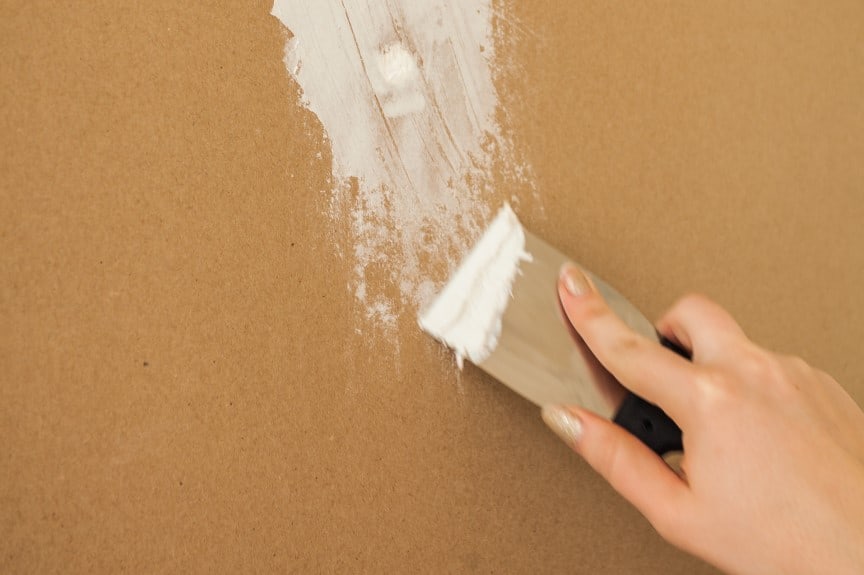

#BEST WAY TO COVER HOLES IN WALL PATCH#
Sand the patch a final time, making sure the wall is completely smooth.Apply a final layer of drywall mud, feathering the wall patch into the rest of the wall. Sand away rough spots and wipe with a damp cloth.If you can still see the seams, apply another layer of paper tape. Sand off any rough spots and wipe clean with a damp cloth.Then press the drywall tape firmly into the joints to hide the seams. Use the drywall knife to apply a coat of mud around the edges.For larger repairs, place screws 12 to 16 inches apart. Use drywall screws and attach the new piece to the exposed wall studs.Check that the new piece fits with no more than a quarter of an inch gap on all sides. Measure the hole, then cut a piece of drywall that is just slightly smaller than the opening.Then sand the edges of the drywall joint and wipe them with a damp cloth. Clean the hole with a shop vac to remove loose material and debris.However, expose two or more studs if the hole is larger than twelve inches. Use a sharp utility knife or a drywall saw to square up the hole.Otherwise, the weight of the patch can cause future cracks or it will even fall down while drying.Ĩ Steps To Fix Holes in the Wall Larger Than Five Inches Repairing wall holes larger than five inches involves cutting a new piece of drywall and securing it to the wall studs. Let the joint compound dry, then sand it smooth. If the wall isn’t smooth or there are gaps, holes, or visible edges, apply another layer of spackle. Gently sand the patch, making sure to feather it in with the rest of the wall for a smooth finish.Feather the spackling out from the patch to get a smooth wall surface and allow it to dry completely. If you used mesh drywall tape, apply another layer of tape in a crisscross pattern for added strength and durability. Spread a thin coat of compound across the entire patch, being careful not to use too much pressure.Apply the tape in the same direction, just barely overlapping each piece. Then cover the hole with strips of mesh tape and let them dry. If you are using drywall mesh tape, apply a thin layer of joint compound around the edge of the hole. For self-sticking patches, cut the patch to match the size of the hole and stick it down.Then gently sand the edges and wipe the area with a damp cloth.

Use a shop vac to clean out the hole and remove loose debris.Then cover the patch with joint compound or spackling.Ĥ Steps To Fix Wall Holes Up to Five Inches: For doorknob holes, use galvanized-metal patches for added strength. While you can buy rolls of mesh tape in several widths, self-adhesive mesh patch kits are also available. Otherwise, the patch will never really set. You will need to reinforce medium-sized holes between one and a half and five inches with fiberglass mesh tape. Sand the drywall patch for a smooth surface.Use the putty knife to apply a thin layer of compound to the hole and allow it to dry overnight.Gently sand the hole to smooth out rough edges, then wipe the area with a damp cloth.Sand the drywall surface until it is smooth.įrom screw or nail holes up to anything an inch and a half, you can fill wall holes with a coat of spackle or joint compound using a putty knife.ģ Easy Steps To Repair Small Drywall Holes:.Apply a lightweight spackle with a putty knife and let it dry overnight.Sand the dent lightly to remove rough spots and wipe clean with a damp cloth.You can easily repair drywall dings and dents using lightweight spackle.ģ Simple Steps To Repair Drywall Dings and Dents: No matter the size of the hole, here are the basics of drywall repairs. Also, use a dust mask or ventilator when sanding drywall mud. You can repair holes in drywall for as little as $5 for some spackling, but it may cost anywhere from $25 to $75 if you need to buy drywall or tools.įor your safety, always wear eye protection when repairing drywall damage. You can repair wall dings and small holes with wall spackle and a putty knife, but large ones require a mesh patch or even replacing a section of drywall. The best way to fix a hole in the wall depends on the size.
#BEST WAY TO COVER HOLES IN WALL HOW TO#
From nail and screw holes to serious drywall damage, we explain how to fix a hole in the wall. In some cases, you might need to replace the drywall. However, large ones need at least fiberglass mesh to reinforce the wall.


Do you have a bunch of nail holes that need filling? Maybe the doorknob accidentally got pushed through the wall? With wall spackling, you can fix most small holes.


 0 kommentar(er)
0 kommentar(er)
